Building Information Modelling and MEP Assessment: A Detailed Analysis
VerifiedAdded on 2019/10/09
|40
|7435
|497
Report
AI Summary
This report presents a comprehensive assessment of Building Information Modelling (BIM) and its application in MEP (Mechanical, Electrical, and Plumbing) systems. The study begins with an introduction to BIM, its elements, and significant features, followed by a literature review exploring BIM's benefits, levels, and associated risks. The report then delves into a critical analysis of a building's data using BIM tools, specifically Autodesk Revit, to evaluate energy consumption and explore the impact of design modifications. The analysis includes a detailed discussion of annual and monthly energy data, results before and after design changes, and conclusions about energy savings. The report covers the industrial uses of BIM, its importance in construction, and its role in multidisciplinary design projects, meeting industrial standards, and ensuring an effective BIM environment. The assessment highlights the advantages of BIM in reducing life cycle costs and improving productivity in construction activities. This report offers a complete overview of BIM, MEP, and its benefits with critical analysis.

BUILDING INFORMATION MODELLING AND MEP ASSESSMENT
APRIL 24, 2019
APRIL 24, 2019
Paraphrase This Document
Need a fresh take? Get an instant paraphrase of this document with our AI Paraphraser
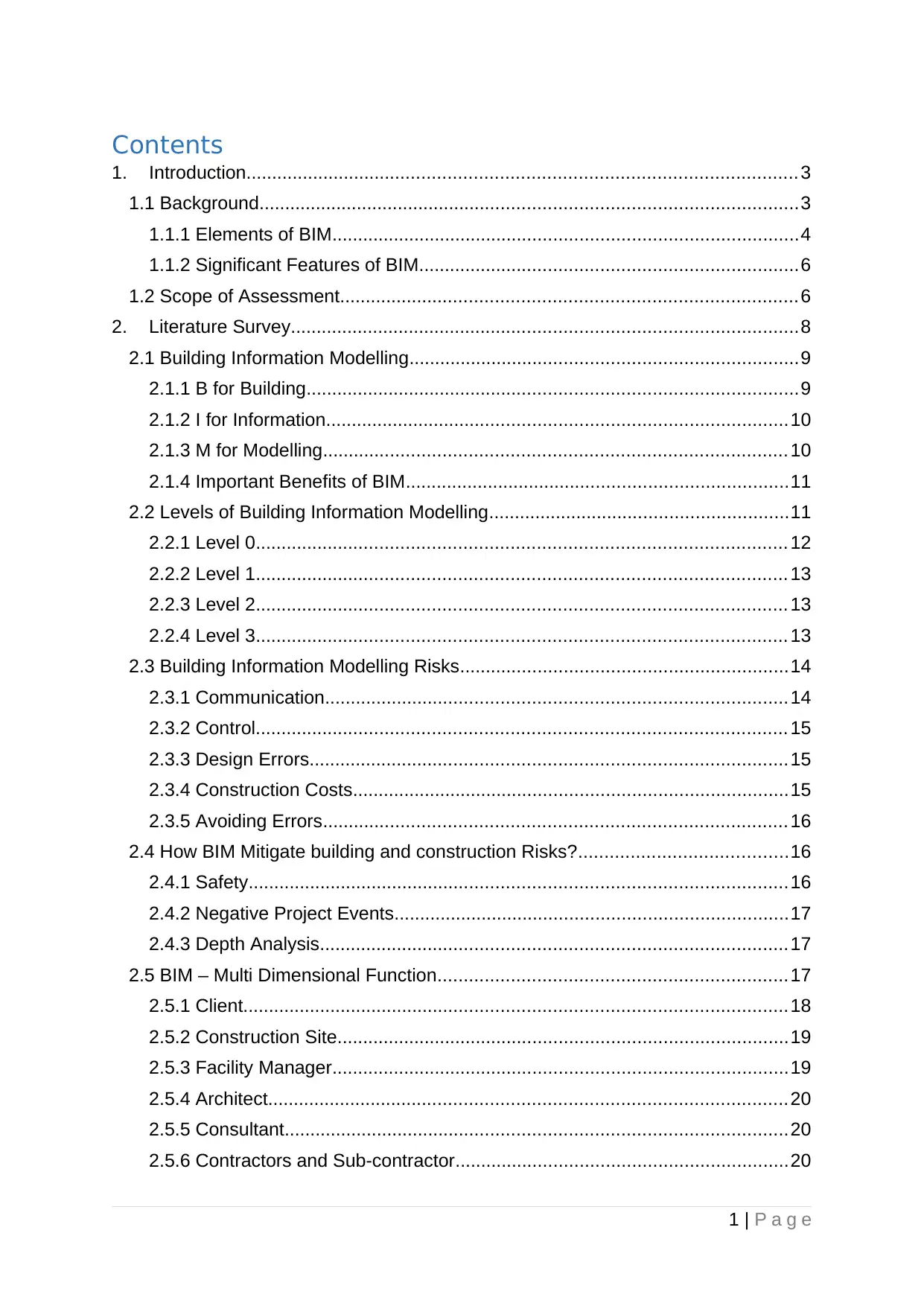
Contents
1. Introduction.......................................................................................................... 3
1.1 Background........................................................................................................3
1.1.1 Elements of BIM..........................................................................................4
1.1.2 Significant Features of BIM.........................................................................6
1.2 Scope of Assessment........................................................................................6
2. Literature Survey..................................................................................................8
2.1 Building Information Modelling...........................................................................9
2.1.1 B for Building...............................................................................................9
2.1.2 I for Information.........................................................................................10
2.1.3 M for Modelling......................................................................................... 10
2.1.4 Important Benefits of BIM..........................................................................11
2.2 Levels of Building Information Modelling..........................................................11
2.2.1 Level 0...................................................................................................... 12
2.2.2 Level 1...................................................................................................... 13
2.2.3 Level 2...................................................................................................... 13
2.2.4 Level 3...................................................................................................... 13
2.3 Building Information Modelling Risks...............................................................14
2.3.1 Communication.........................................................................................14
2.3.2 Control...................................................................................................... 15
2.3.3 Design Errors............................................................................................15
2.3.4 Construction Costs....................................................................................15
2.3.5 Avoiding Errors......................................................................................... 16
2.4 How BIM Mitigate building and construction Risks?........................................16
2.4.1 Safety........................................................................................................16
2.4.2 Negative Project Events............................................................................17
2.4.3 Depth Analysis..........................................................................................17
2.5 BIM – Multi Dimensional Function...................................................................17
2.5.1 Client.........................................................................................................18
2.5.2 Construction Site.......................................................................................19
2.5.3 Facility Manager........................................................................................19
2.5.4 Architect....................................................................................................20
2.5.5 Consultant.................................................................................................20
2.5.6 Contractors and Sub-contractor................................................................20
1 | P a g e
1. Introduction.......................................................................................................... 3
1.1 Background........................................................................................................3
1.1.1 Elements of BIM..........................................................................................4
1.1.2 Significant Features of BIM.........................................................................6
1.2 Scope of Assessment........................................................................................6
2. Literature Survey..................................................................................................8
2.1 Building Information Modelling...........................................................................9
2.1.1 B for Building...............................................................................................9
2.1.2 I for Information.........................................................................................10
2.1.3 M for Modelling......................................................................................... 10
2.1.4 Important Benefits of BIM..........................................................................11
2.2 Levels of Building Information Modelling..........................................................11
2.2.1 Level 0...................................................................................................... 12
2.2.2 Level 1...................................................................................................... 13
2.2.3 Level 2...................................................................................................... 13
2.2.4 Level 3...................................................................................................... 13
2.3 Building Information Modelling Risks...............................................................14
2.3.1 Communication.........................................................................................14
2.3.2 Control...................................................................................................... 15
2.3.3 Design Errors............................................................................................15
2.3.4 Construction Costs....................................................................................15
2.3.5 Avoiding Errors......................................................................................... 16
2.4 How BIM Mitigate building and construction Risks?........................................16
2.4.1 Safety........................................................................................................16
2.4.2 Negative Project Events............................................................................17
2.4.3 Depth Analysis..........................................................................................17
2.5 BIM – Multi Dimensional Function...................................................................17
2.5.1 Client.........................................................................................................18
2.5.2 Construction Site.......................................................................................19
2.5.3 Facility Manager........................................................................................19
2.5.4 Architect....................................................................................................20
2.5.5 Consultant.................................................................................................20
2.5.6 Contractors and Sub-contractor................................................................20
1 | P a g e
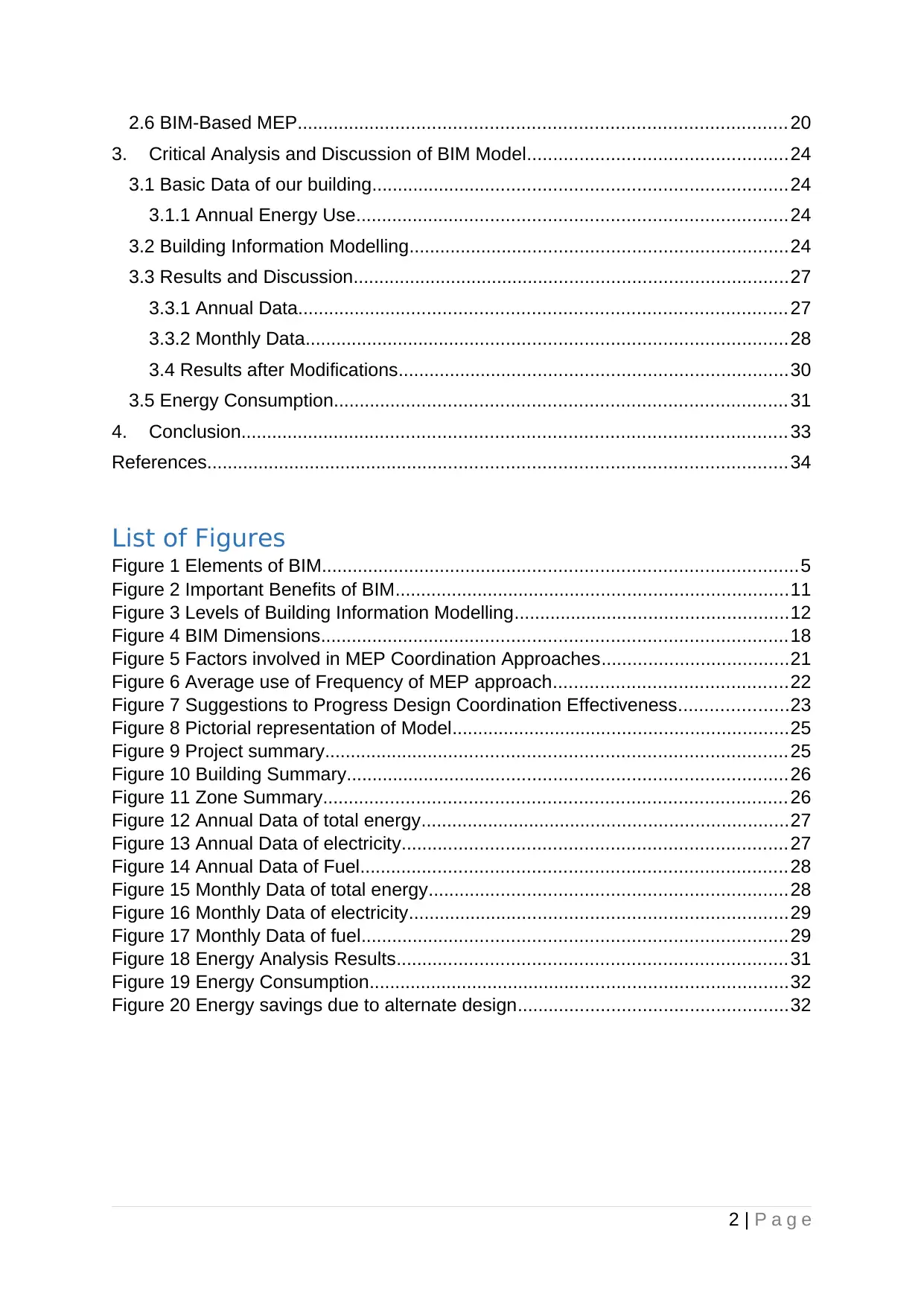
2.6 BIM-Based MEP.............................................................................................. 20
3. Critical Analysis and Discussion of BIM Model..................................................24
3.1 Basic Data of our building................................................................................24
3.1.1 Annual Energy Use...................................................................................24
3.2 Building Information Modelling.........................................................................24
3.3 Results and Discussion....................................................................................27
3.3.1 Annual Data.............................................................................................. 27
3.3.2 Monthly Data.............................................................................................28
3.4 Results after Modifications...........................................................................30
3.5 Energy Consumption....................................................................................... 31
4. Conclusion......................................................................................................... 33
References................................................................................................................34
List of Figures
Figure 1 Elements of BIM............................................................................................5
Figure 2 Important Benefits of BIM............................................................................11
Figure 3 Levels of Building Information Modelling.....................................................12
Figure 4 BIM Dimensions..........................................................................................18
Figure 5 Factors involved in MEP Coordination Approaches....................................21
Figure 6 Average use of Frequency of MEP approach.............................................22
Figure 7 Suggestions to Progress Design Coordination Effectiveness.....................23
Figure 8 Pictorial representation of Model.................................................................25
Figure 9 Project summary.........................................................................................25
Figure 10 Building Summary.....................................................................................26
Figure 11 Zone Summary......................................................................................... 26
Figure 12 Annual Data of total energy.......................................................................27
Figure 13 Annual Data of electricity..........................................................................27
Figure 14 Annual Data of Fuel..................................................................................28
Figure 15 Monthly Data of total energy.....................................................................28
Figure 16 Monthly Data of electricity.........................................................................29
Figure 17 Monthly Data of fuel..................................................................................29
Figure 18 Energy Analysis Results...........................................................................31
Figure 19 Energy Consumption.................................................................................32
Figure 20 Energy savings due to alternate design....................................................32
2 | P a g e
3. Critical Analysis and Discussion of BIM Model..................................................24
3.1 Basic Data of our building................................................................................24
3.1.1 Annual Energy Use...................................................................................24
3.2 Building Information Modelling.........................................................................24
3.3 Results and Discussion....................................................................................27
3.3.1 Annual Data.............................................................................................. 27
3.3.2 Monthly Data.............................................................................................28
3.4 Results after Modifications...........................................................................30
3.5 Energy Consumption....................................................................................... 31
4. Conclusion......................................................................................................... 33
References................................................................................................................34
List of Figures
Figure 1 Elements of BIM............................................................................................5
Figure 2 Important Benefits of BIM............................................................................11
Figure 3 Levels of Building Information Modelling.....................................................12
Figure 4 BIM Dimensions..........................................................................................18
Figure 5 Factors involved in MEP Coordination Approaches....................................21
Figure 6 Average use of Frequency of MEP approach.............................................22
Figure 7 Suggestions to Progress Design Coordination Effectiveness.....................23
Figure 8 Pictorial representation of Model.................................................................25
Figure 9 Project summary.........................................................................................25
Figure 10 Building Summary.....................................................................................26
Figure 11 Zone Summary......................................................................................... 26
Figure 12 Annual Data of total energy.......................................................................27
Figure 13 Annual Data of electricity..........................................................................27
Figure 14 Annual Data of Fuel..................................................................................28
Figure 15 Monthly Data of total energy.....................................................................28
Figure 16 Monthly Data of electricity.........................................................................29
Figure 17 Monthly Data of fuel..................................................................................29
Figure 18 Energy Analysis Results...........................................................................31
Figure 19 Energy Consumption.................................................................................32
Figure 20 Energy savings due to alternate design....................................................32
2 | P a g e
⊘ This is a preview!⊘
Do you want full access?
Subscribe today to unlock all pages.

Trusted by 1+ million students worldwide
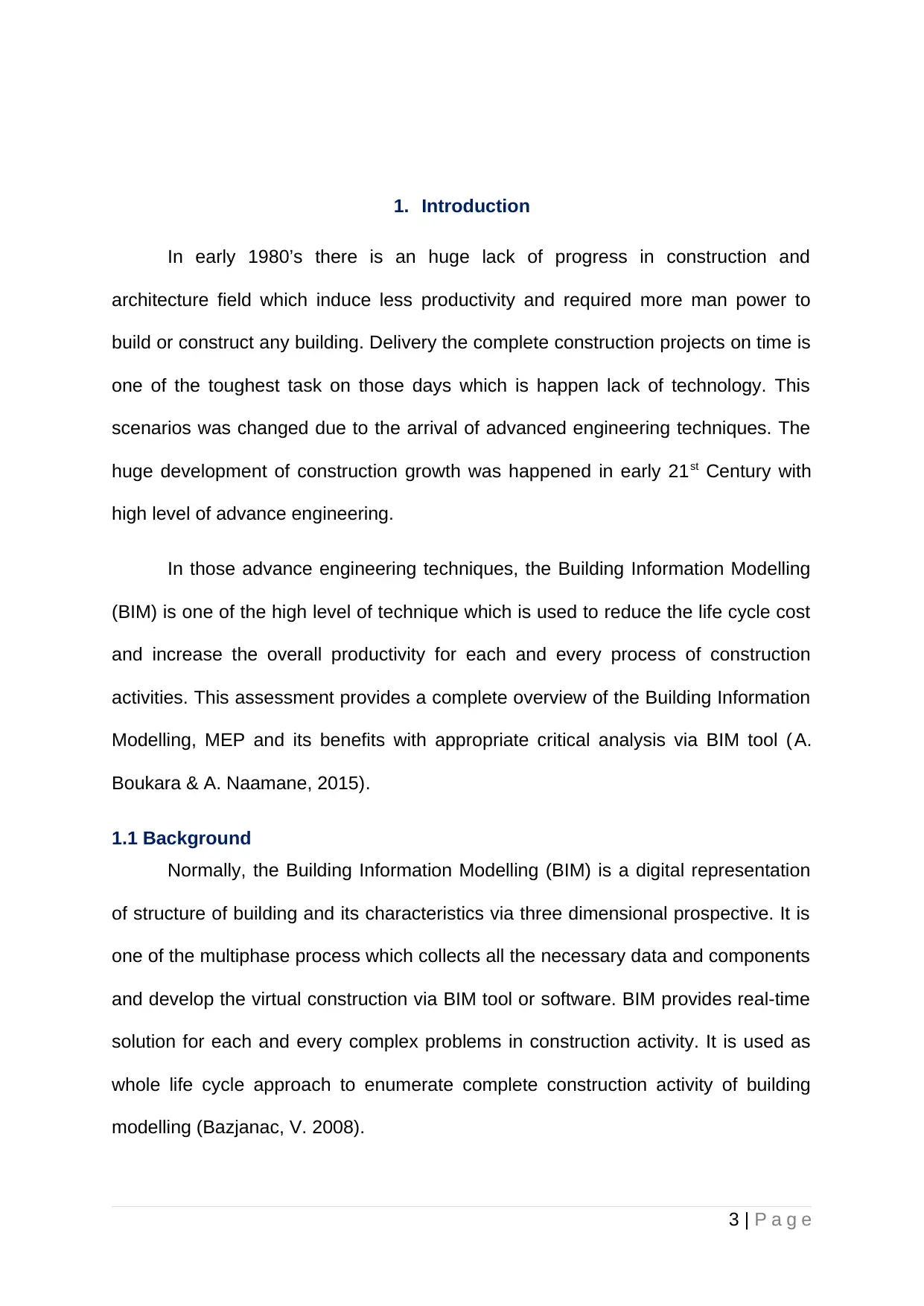
1. Introduction
In early 1980’s there is an huge lack of progress in construction and
architecture field which induce less productivity and required more man power to
build or construct any building. Delivery the complete construction projects on time is
one of the toughest task on those days which is happen lack of technology. This
scenarios was changed due to the arrival of advanced engineering techniques. The
huge development of construction growth was happened in early 21st Century with
high level of advance engineering.
In those advance engineering techniques, the Building Information Modelling
(BIM) is one of the high level of technique which is used to reduce the life cycle cost
and increase the overall productivity for each and every process of construction
activities. This assessment provides a complete overview of the Building Information
Modelling, MEP and its benefits with appropriate critical analysis via BIM tool ( A.
Boukara & A. Naamane, 2015).
1.1 Background
Normally, the Building Information Modelling (BIM) is a digital representation
of structure of building and its characteristics via three dimensional prospective. It is
one of the multiphase process which collects all the necessary data and components
and develop the virtual construction via BIM tool or software. BIM provides real-time
solution for each and every complex problems in construction activity. It is used as
whole life cycle approach to enumerate complete construction activity of building
modelling (Bazjanac, V. 2008).
3 | P a g e
In early 1980’s there is an huge lack of progress in construction and
architecture field which induce less productivity and required more man power to
build or construct any building. Delivery the complete construction projects on time is
one of the toughest task on those days which is happen lack of technology. This
scenarios was changed due to the arrival of advanced engineering techniques. The
huge development of construction growth was happened in early 21st Century with
high level of advance engineering.
In those advance engineering techniques, the Building Information Modelling
(BIM) is one of the high level of technique which is used to reduce the life cycle cost
and increase the overall productivity for each and every process of construction
activities. This assessment provides a complete overview of the Building Information
Modelling, MEP and its benefits with appropriate critical analysis via BIM tool ( A.
Boukara & A. Naamane, 2015).
1.1 Background
Normally, the Building Information Modelling (BIM) is a digital representation
of structure of building and its characteristics via three dimensional prospective. It is
one of the multiphase process which collects all the necessary data and components
and develop the virtual construction via BIM tool or software. BIM provides real-time
solution for each and every complex problems in construction activity. It is used as
whole life cycle approach to enumerate complete construction activity of building
modelling (Bazjanac, V. 2008).
3 | P a g e
Paraphrase This Document
Need a fresh take? Get an instant paraphrase of this document with our AI Paraphraser
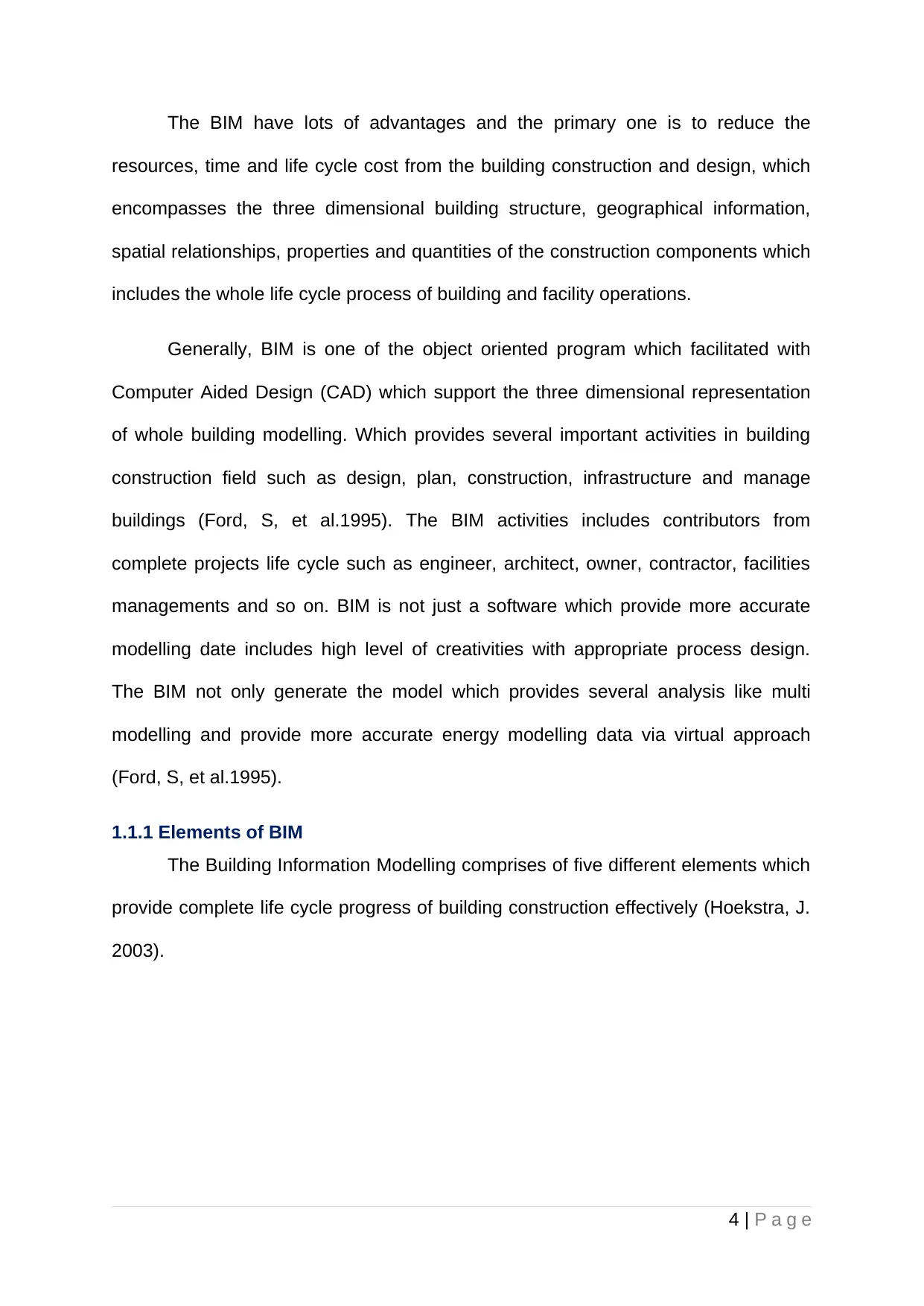
The BIM have lots of advantages and the primary one is to reduce the
resources, time and life cycle cost from the building construction and design, which
encompasses the three dimensional building structure, geographical information,
spatial relationships, properties and quantities of the construction components which
includes the whole life cycle process of building and facility operations.
Generally, BIM is one of the object oriented program which facilitated with
Computer Aided Design (CAD) which support the three dimensional representation
of whole building modelling. Which provides several important activities in building
construction field such as design, plan, construction, infrastructure and manage
buildings (Ford, S, et al.1995). The BIM activities includes contributors from
complete projects life cycle such as engineer, architect, owner, contractor, facilities
managements and so on. BIM is not just a software which provide more accurate
modelling date includes high level of creativities with appropriate process design.
The BIM not only generate the model which provides several analysis like multi
modelling and provide more accurate energy modelling data via virtual approach
(Ford, S, et al.1995).
1.1.1 Elements of BIM
The Building Information Modelling comprises of five different elements which
provide complete life cycle progress of building construction effectively (Hoekstra, J.
2003).
4 | P a g e
resources, time and life cycle cost from the building construction and design, which
encompasses the three dimensional building structure, geographical information,
spatial relationships, properties and quantities of the construction components which
includes the whole life cycle process of building and facility operations.
Generally, BIM is one of the object oriented program which facilitated with
Computer Aided Design (CAD) which support the three dimensional representation
of whole building modelling. Which provides several important activities in building
construction field such as design, plan, construction, infrastructure and manage
buildings (Ford, S, et al.1995). The BIM activities includes contributors from
complete projects life cycle such as engineer, architect, owner, contractor, facilities
managements and so on. BIM is not just a software which provide more accurate
modelling date includes high level of creativities with appropriate process design.
The BIM not only generate the model which provides several analysis like multi
modelling and provide more accurate energy modelling data via virtual approach
(Ford, S, et al.1995).
1.1.1 Elements of BIM
The Building Information Modelling comprises of five different elements which
provide complete life cycle progress of building construction effectively (Hoekstra, J.
2003).
4 | P a g e
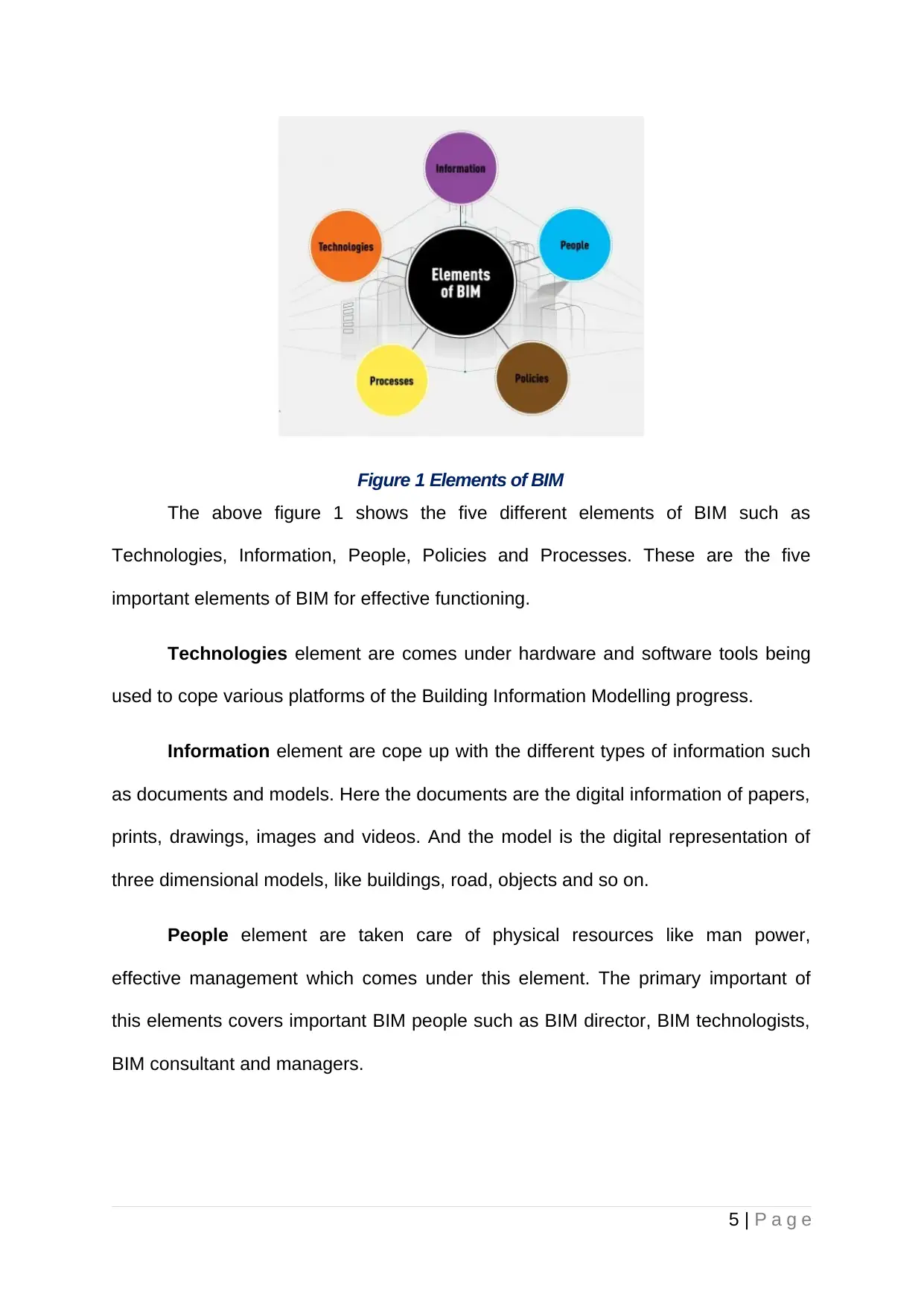
Figure 1 Elements of BIM
The above figure 1 shows the five different elements of BIM such as
Technologies, Information, People, Policies and Processes. These are the five
important elements of BIM for effective functioning.
Technologies element are comes under hardware and software tools being
used to cope various platforms of the Building Information Modelling progress.
Information element are cope up with the different types of information such
as documents and models. Here the documents are the digital information of papers,
prints, drawings, images and videos. And the model is the digital representation of
three dimensional models, like buildings, road, objects and so on.
People element are taken care of physical resources like man power,
effective management which comes under this element. The primary important of
this elements covers important BIM people such as BIM director, BIM technologists,
BIM consultant and managers.
5 | P a g e
The above figure 1 shows the five different elements of BIM such as
Technologies, Information, People, Policies and Processes. These are the five
important elements of BIM for effective functioning.
Technologies element are comes under hardware and software tools being
used to cope various platforms of the Building Information Modelling progress.
Information element are cope up with the different types of information such
as documents and models. Here the documents are the digital information of papers,
prints, drawings, images and videos. And the model is the digital representation of
three dimensional models, like buildings, road, objects and so on.
People element are taken care of physical resources like man power,
effective management which comes under this element. The primary important of
this elements covers important BIM people such as BIM director, BIM technologists,
BIM consultant and managers.
5 | P a g e
⊘ This is a preview!⊘
Do you want full access?
Subscribe today to unlock all pages.

Trusted by 1+ million students worldwide
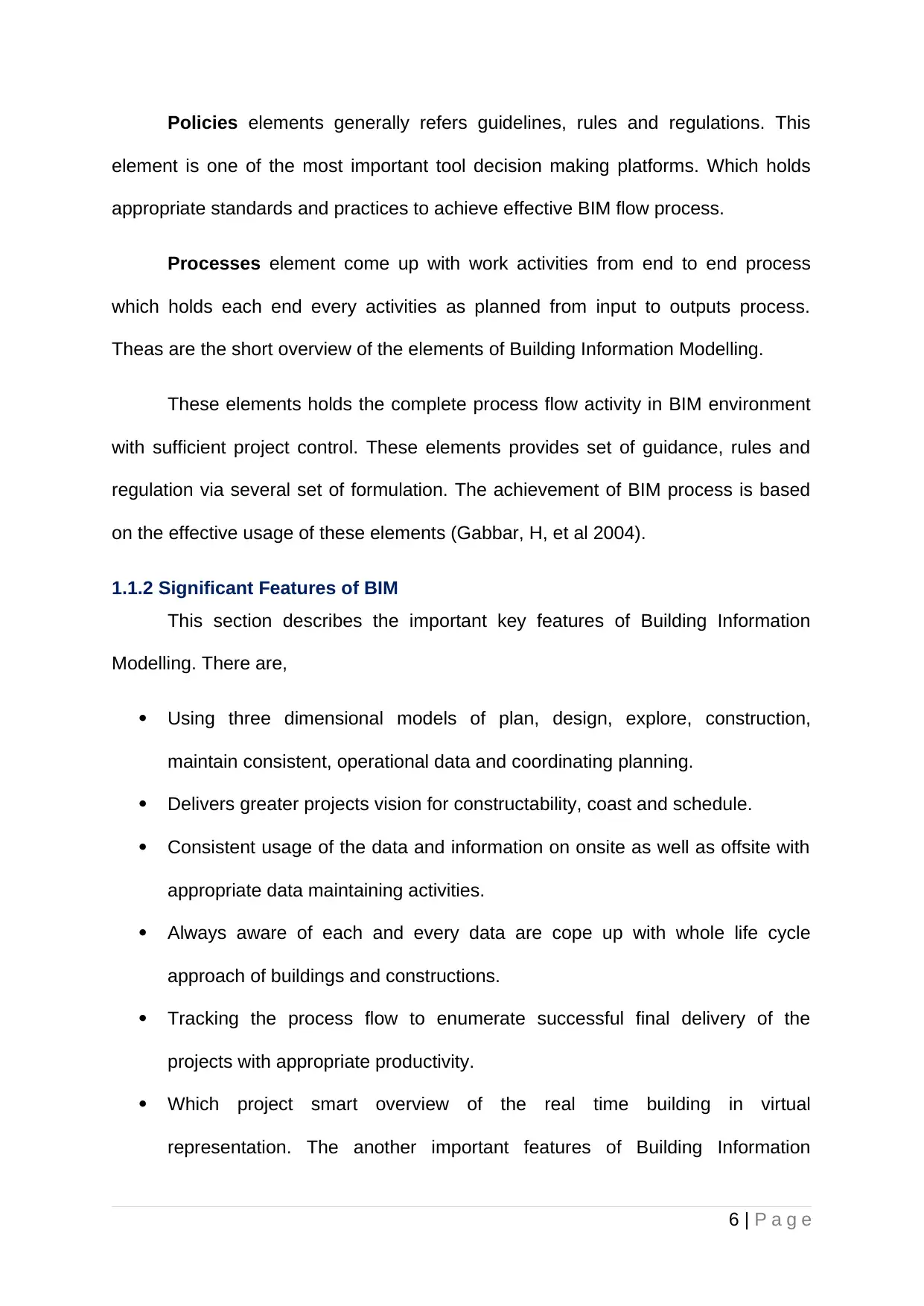
Policies elements generally refers guidelines, rules and regulations. This
element is one of the most important tool decision making platforms. Which holds
appropriate standards and practices to achieve effective BIM flow process.
Processes element come up with work activities from end to end process
which holds each end every activities as planned from input to outputs process.
Theas are the short overview of the elements of Building Information Modelling.
These elements holds the complete process flow activity in BIM environment
with sufficient project control. These elements provides set of guidance, rules and
regulation via several set of formulation. The achievement of BIM process is based
on the effective usage of these elements (Gabbar, H, et al 2004).
1.1.2 Significant Features of BIM
This section describes the important key features of Building Information
Modelling. There are,
Using three dimensional models of plan, design, explore, construction,
maintain consistent, operational data and coordinating planning.
Delivers greater projects vision for constructability, coast and schedule.
Consistent usage of the data and information on onsite as well as offsite with
appropriate data maintaining activities.
Always aware of each and every data are cope up with whole life cycle
approach of buildings and constructions.
Tracking the process flow to enumerate successful final delivery of the
projects with appropriate productivity.
Which project smart overview of the real time building in virtual
representation. The another important features of Building Information
6 | P a g e
element is one of the most important tool decision making platforms. Which holds
appropriate standards and practices to achieve effective BIM flow process.
Processes element come up with work activities from end to end process
which holds each end every activities as planned from input to outputs process.
Theas are the short overview of the elements of Building Information Modelling.
These elements holds the complete process flow activity in BIM environment
with sufficient project control. These elements provides set of guidance, rules and
regulation via several set of formulation. The achievement of BIM process is based
on the effective usage of these elements (Gabbar, H, et al 2004).
1.1.2 Significant Features of BIM
This section describes the important key features of Building Information
Modelling. There are,
Using three dimensional models of plan, design, explore, construction,
maintain consistent, operational data and coordinating planning.
Delivers greater projects vision for constructability, coast and schedule.
Consistent usage of the data and information on onsite as well as offsite with
appropriate data maintaining activities.
Always aware of each and every data are cope up with whole life cycle
approach of buildings and constructions.
Tracking the process flow to enumerate successful final delivery of the
projects with appropriate productivity.
Which project smart overview of the real time building in virtual
representation. The another important features of Building Information
6 | P a g e
Paraphrase This Document
Need a fresh take? Get an instant paraphrase of this document with our AI Paraphraser
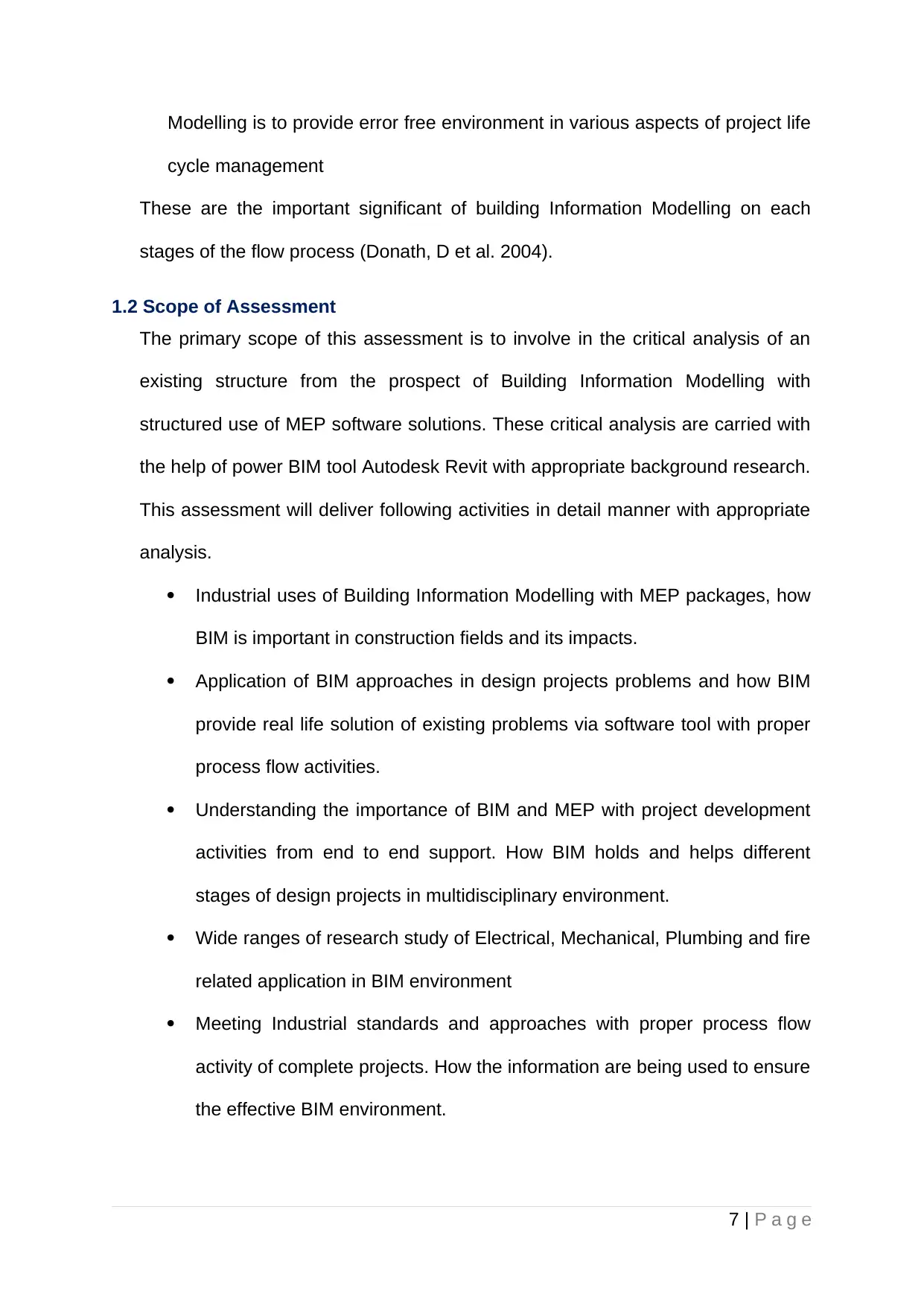
Modelling is to provide error free environment in various aspects of project life
cycle management
These are the important significant of building Information Modelling on each
stages of the flow process (Donath, D et al. 2004).
1.2 Scope of Assessment
The primary scope of this assessment is to involve in the critical analysis of an
existing structure from the prospect of Building Information Modelling with
structured use of MEP software solutions. These critical analysis are carried with
the help of power BIM tool Autodesk Revit with appropriate background research.
This assessment will deliver following activities in detail manner with appropriate
analysis.
Industrial uses of Building Information Modelling with MEP packages, how
BIM is important in construction fields and its impacts.
Application of BIM approaches in design projects problems and how BIM
provide real life solution of existing problems via software tool with proper
process flow activities.
Understanding the importance of BIM and MEP with project development
activities from end to end support. How BIM holds and helps different
stages of design projects in multidisciplinary environment.
Wide ranges of research study of Electrical, Mechanical, Plumbing and fire
related application in BIM environment
Meeting Industrial standards and approaches with proper process flow
activity of complete projects. How the information are being used to ensure
the effective BIM environment.
7 | P a g e
cycle management
These are the important significant of building Information Modelling on each
stages of the flow process (Donath, D et al. 2004).
1.2 Scope of Assessment
The primary scope of this assessment is to involve in the critical analysis of an
existing structure from the prospect of Building Information Modelling with
structured use of MEP software solutions. These critical analysis are carried with
the help of power BIM tool Autodesk Revit with appropriate background research.
This assessment will deliver following activities in detail manner with appropriate
analysis.
Industrial uses of Building Information Modelling with MEP packages, how
BIM is important in construction fields and its impacts.
Application of BIM approaches in design projects problems and how BIM
provide real life solution of existing problems via software tool with proper
process flow activities.
Understanding the importance of BIM and MEP with project development
activities from end to end support. How BIM holds and helps different
stages of design projects in multidisciplinary environment.
Wide ranges of research study of Electrical, Mechanical, Plumbing and fire
related application in BIM environment
Meeting Industrial standards and approaches with proper process flow
activity of complete projects. How the information are being used to ensure
the effective BIM environment.
7 | P a g e

These are the main objectives and scope of this assessment which is done
via several stages of research and enumerated with appropriate discussion.
8 | P a g e
via several stages of research and enumerated with appropriate discussion.
8 | P a g e
⊘ This is a preview!⊘
Do you want full access?
Subscribe today to unlock all pages.

Trusted by 1+ million students worldwide
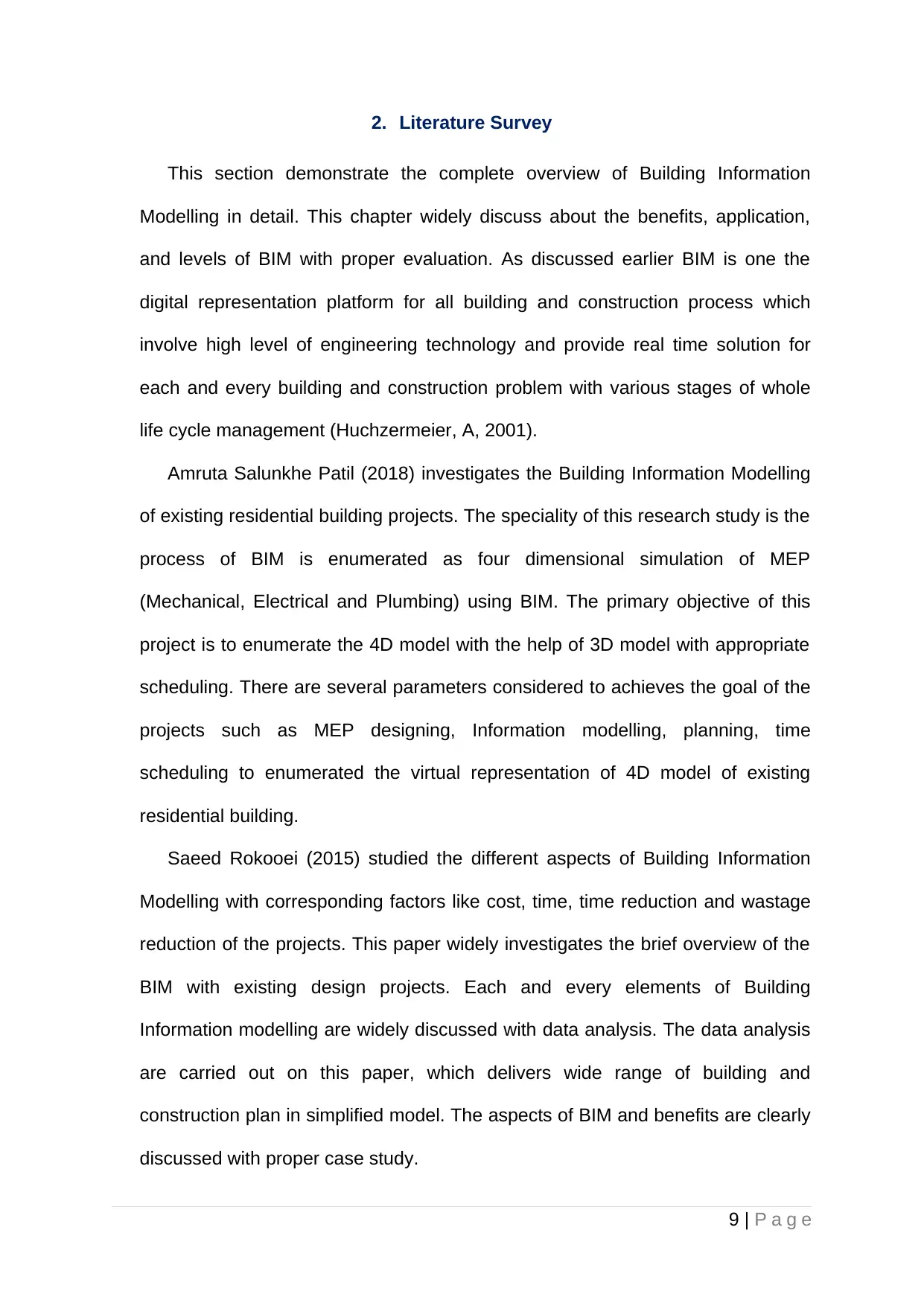
2. Literature Survey
This section demonstrate the complete overview of Building Information
Modelling in detail. This chapter widely discuss about the benefits, application,
and levels of BIM with proper evaluation. As discussed earlier BIM is one the
digital representation platform for all building and construction process which
involve high level of engineering technology and provide real time solution for
each and every building and construction problem with various stages of whole
life cycle management (Huchzermeier, A, 2001).
Amruta Salunkhe Patil (2018) investigates the Building Information Modelling
of existing residential building projects. The speciality of this research study is the
process of BIM is enumerated as four dimensional simulation of MEP
(Mechanical, Electrical and Plumbing) using BIM. The primary objective of this
project is to enumerate the 4D model with the help of 3D model with appropriate
scheduling. There are several parameters considered to achieves the goal of the
projects such as MEP designing, Information modelling, planning, time
scheduling to enumerated the virtual representation of 4D model of existing
residential building.
Saeed Rokooei (2015) studied the different aspects of Building Information
Modelling with corresponding factors like cost, time, time reduction and wastage
reduction of the projects. This paper widely investigates the brief overview of the
BIM with existing design projects. Each and every elements of Building
Information modelling are widely discussed with data analysis. The data analysis
are carried out on this paper, which delivers wide range of building and
construction plan in simplified model. The aspects of BIM and benefits are clearly
discussed with proper case study.
9 | P a g e
This section demonstrate the complete overview of Building Information
Modelling in detail. This chapter widely discuss about the benefits, application,
and levels of BIM with proper evaluation. As discussed earlier BIM is one the
digital representation platform for all building and construction process which
involve high level of engineering technology and provide real time solution for
each and every building and construction problem with various stages of whole
life cycle management (Huchzermeier, A, 2001).
Amruta Salunkhe Patil (2018) investigates the Building Information Modelling
of existing residential building projects. The speciality of this research study is the
process of BIM is enumerated as four dimensional simulation of MEP
(Mechanical, Electrical and Plumbing) using BIM. The primary objective of this
project is to enumerate the 4D model with the help of 3D model with appropriate
scheduling. There are several parameters considered to achieves the goal of the
projects such as MEP designing, Information modelling, planning, time
scheduling to enumerated the virtual representation of 4D model of existing
residential building.
Saeed Rokooei (2015) studied the different aspects of Building Information
Modelling with corresponding factors like cost, time, time reduction and wastage
reduction of the projects. This paper widely investigates the brief overview of the
BIM with existing design projects. Each and every elements of Building
Information modelling are widely discussed with data analysis. The data analysis
are carried out on this paper, which delivers wide range of building and
construction plan in simplified model. The aspects of BIM and benefits are clearly
discussed with proper case study.
9 | P a g e
Paraphrase This Document
Need a fresh take? Get an instant paraphrase of this document with our AI Paraphraser
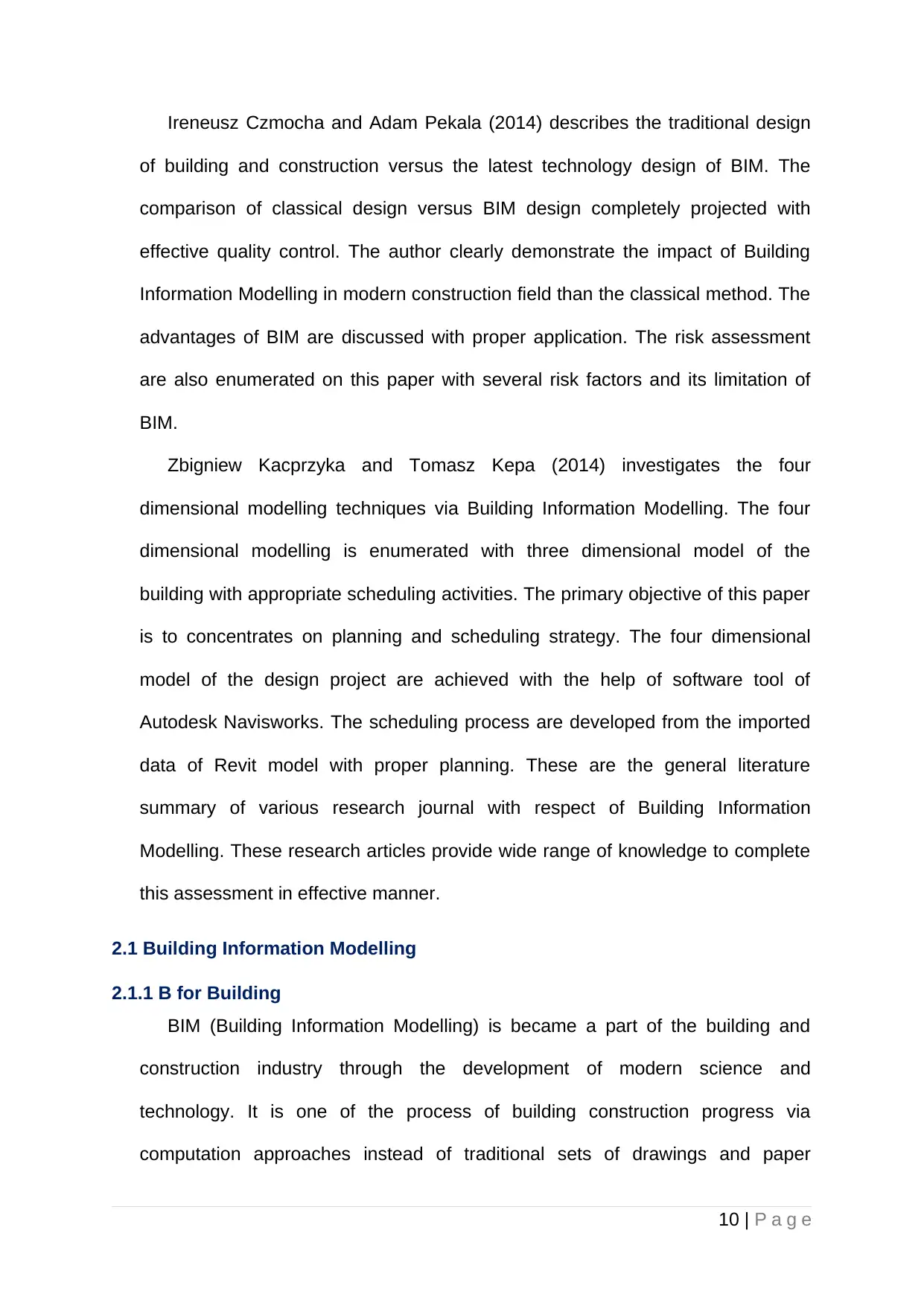
Ireneusz Czmocha and Adam Pekala (2014) describes the traditional design
of building and construction versus the latest technology design of BIM. The
comparison of classical design versus BIM design completely projected with
effective quality control. The author clearly demonstrate the impact of Building
Information Modelling in modern construction field than the classical method. The
advantages of BIM are discussed with proper application. The risk assessment
are also enumerated on this paper with several risk factors and its limitation of
BIM.
Zbigniew Kacprzyka and Tomasz Kepa (2014) investigates the four
dimensional modelling techniques via Building Information Modelling. The four
dimensional modelling is enumerated with three dimensional model of the
building with appropriate scheduling activities. The primary objective of this paper
is to concentrates on planning and scheduling strategy. The four dimensional
model of the design project are achieved with the help of software tool of
Autodesk Navisworks. The scheduling process are developed from the imported
data of Revit model with proper planning. These are the general literature
summary of various research journal with respect of Building Information
Modelling. These research articles provide wide range of knowledge to complete
this assessment in effective manner.
2.1 Building Information Modelling
2.1.1 B for Building
BIM (Building Information Modelling) is became a part of the building and
construction industry through the development of modern science and
technology. It is one of the process of building construction progress via
computation approaches instead of traditional sets of drawings and paper
10 | P a g e
of building and construction versus the latest technology design of BIM. The
comparison of classical design versus BIM design completely projected with
effective quality control. The author clearly demonstrate the impact of Building
Information Modelling in modern construction field than the classical method. The
advantages of BIM are discussed with proper application. The risk assessment
are also enumerated on this paper with several risk factors and its limitation of
BIM.
Zbigniew Kacprzyka and Tomasz Kepa (2014) investigates the four
dimensional modelling techniques via Building Information Modelling. The four
dimensional modelling is enumerated with three dimensional model of the
building with appropriate scheduling activities. The primary objective of this paper
is to concentrates on planning and scheduling strategy. The four dimensional
model of the design project are achieved with the help of software tool of
Autodesk Navisworks. The scheduling process are developed from the imported
data of Revit model with proper planning. These are the general literature
summary of various research journal with respect of Building Information
Modelling. These research articles provide wide range of knowledge to complete
this assessment in effective manner.
2.1 Building Information Modelling
2.1.1 B for Building
BIM (Building Information Modelling) is became a part of the building and
construction industry through the development of modern science and
technology. It is one of the process of building construction progress via
computation approaches instead of traditional sets of drawings and paper
10 | P a g e
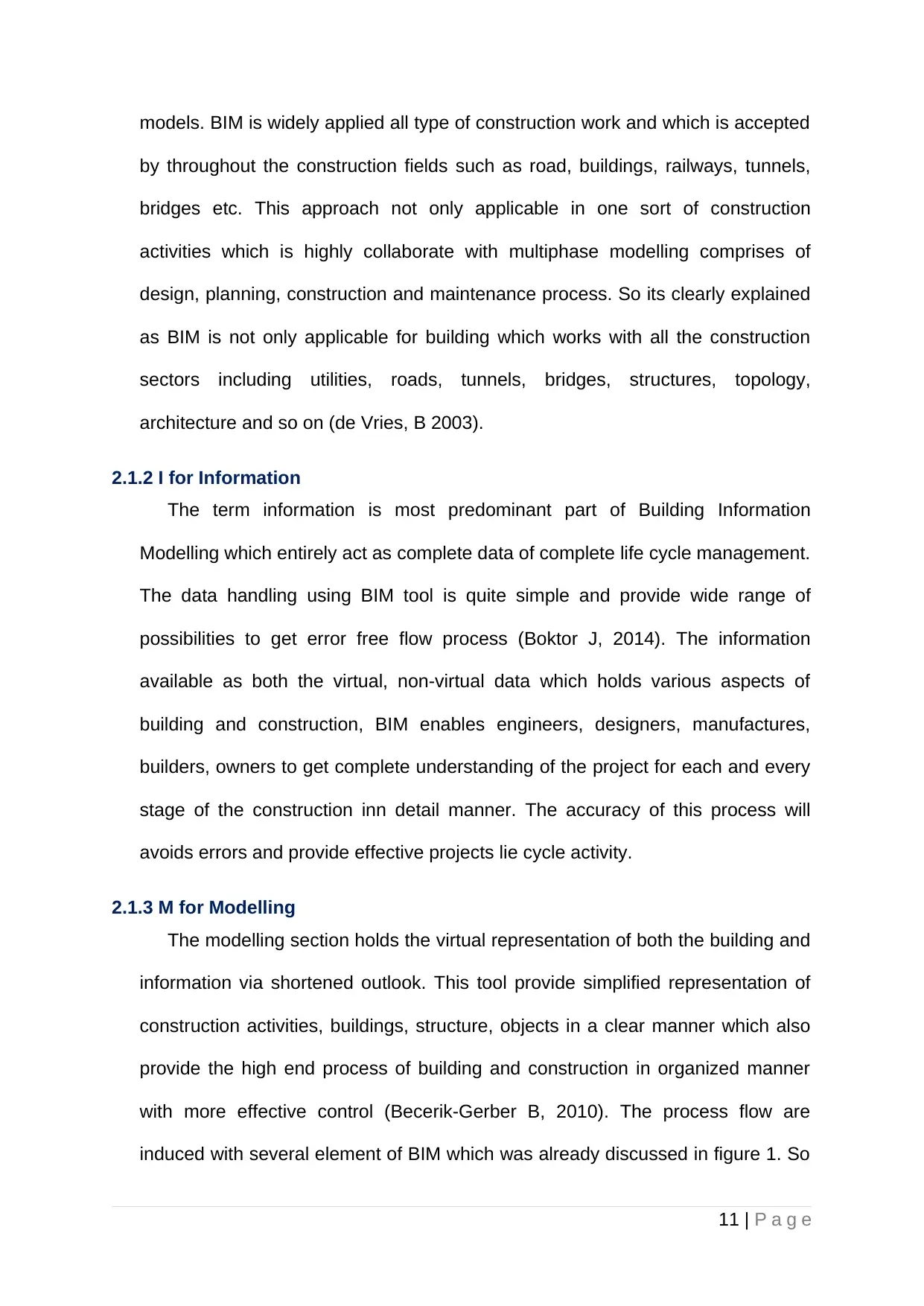
models. BIM is widely applied all type of construction work and which is accepted
by throughout the construction fields such as road, buildings, railways, tunnels,
bridges etc. This approach not only applicable in one sort of construction
activities which is highly collaborate with multiphase modelling comprises of
design, planning, construction and maintenance process. So its clearly explained
as BIM is not only applicable for building which works with all the construction
sectors including utilities, roads, tunnels, bridges, structures, topology,
architecture and so on (de Vries, B 2003).
2.1.2 I for Information
The term information is most predominant part of Building Information
Modelling which entirely act as complete data of complete life cycle management.
The data handling using BIM tool is quite simple and provide wide range of
possibilities to get error free flow process (Boktor J, 2014). The information
available as both the virtual, non-virtual data which holds various aspects of
building and construction, BIM enables engineers, designers, manufactures,
builders, owners to get complete understanding of the project for each and every
stage of the construction inn detail manner. The accuracy of this process will
avoids errors and provide effective projects lie cycle activity.
2.1.3 M for Modelling
The modelling section holds the virtual representation of both the building and
information via shortened outlook. This tool provide simplified representation of
construction activities, buildings, structure, objects in a clear manner which also
provide the high end process of building and construction in organized manner
with more effective control (Becerik-Gerber B, 2010). The process flow are
induced with several element of BIM which was already discussed in figure 1. So
11 | P a g e
by throughout the construction fields such as road, buildings, railways, tunnels,
bridges etc. This approach not only applicable in one sort of construction
activities which is highly collaborate with multiphase modelling comprises of
design, planning, construction and maintenance process. So its clearly explained
as BIM is not only applicable for building which works with all the construction
sectors including utilities, roads, tunnels, bridges, structures, topology,
architecture and so on (de Vries, B 2003).
2.1.2 I for Information
The term information is most predominant part of Building Information
Modelling which entirely act as complete data of complete life cycle management.
The data handling using BIM tool is quite simple and provide wide range of
possibilities to get error free flow process (Boktor J, 2014). The information
available as both the virtual, non-virtual data which holds various aspects of
building and construction, BIM enables engineers, designers, manufactures,
builders, owners to get complete understanding of the project for each and every
stage of the construction inn detail manner. The accuracy of this process will
avoids errors and provide effective projects lie cycle activity.
2.1.3 M for Modelling
The modelling section holds the virtual representation of both the building and
information via shortened outlook. This tool provide simplified representation of
construction activities, buildings, structure, objects in a clear manner which also
provide the high end process of building and construction in organized manner
with more effective control (Becerik-Gerber B, 2010). The process flow are
induced with several element of BIM which was already discussed in figure 1. So
11 | P a g e
⊘ This is a preview!⊘
Do you want full access?
Subscribe today to unlock all pages.

Trusted by 1+ million students worldwide
1 out of 40
Related Documents
Your All-in-One AI-Powered Toolkit for Academic Success.
+13062052269
info@desklib.com
Available 24*7 on WhatsApp / Email
![[object Object]](/_next/static/media/star-bottom.7253800d.svg)
Unlock your academic potential
Copyright © 2020–2025 A2Z Services. All Rights Reserved. Developed and managed by ZUCOL.




